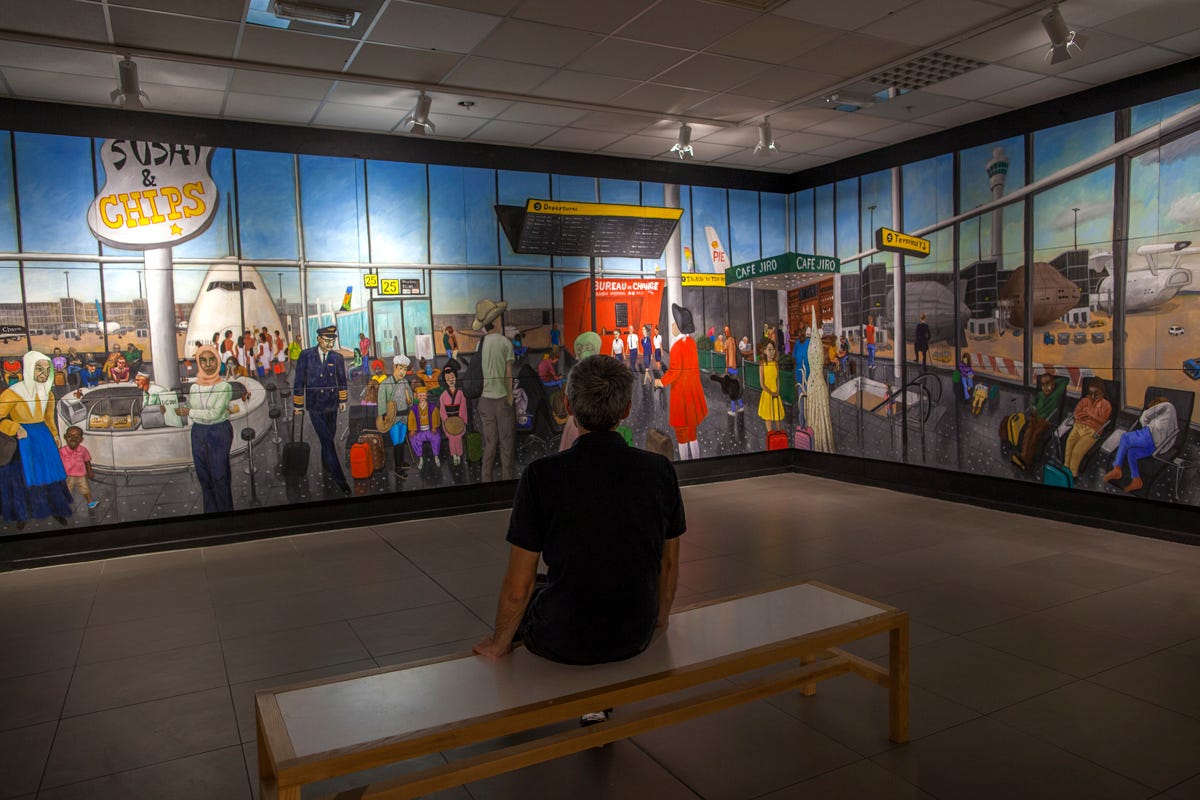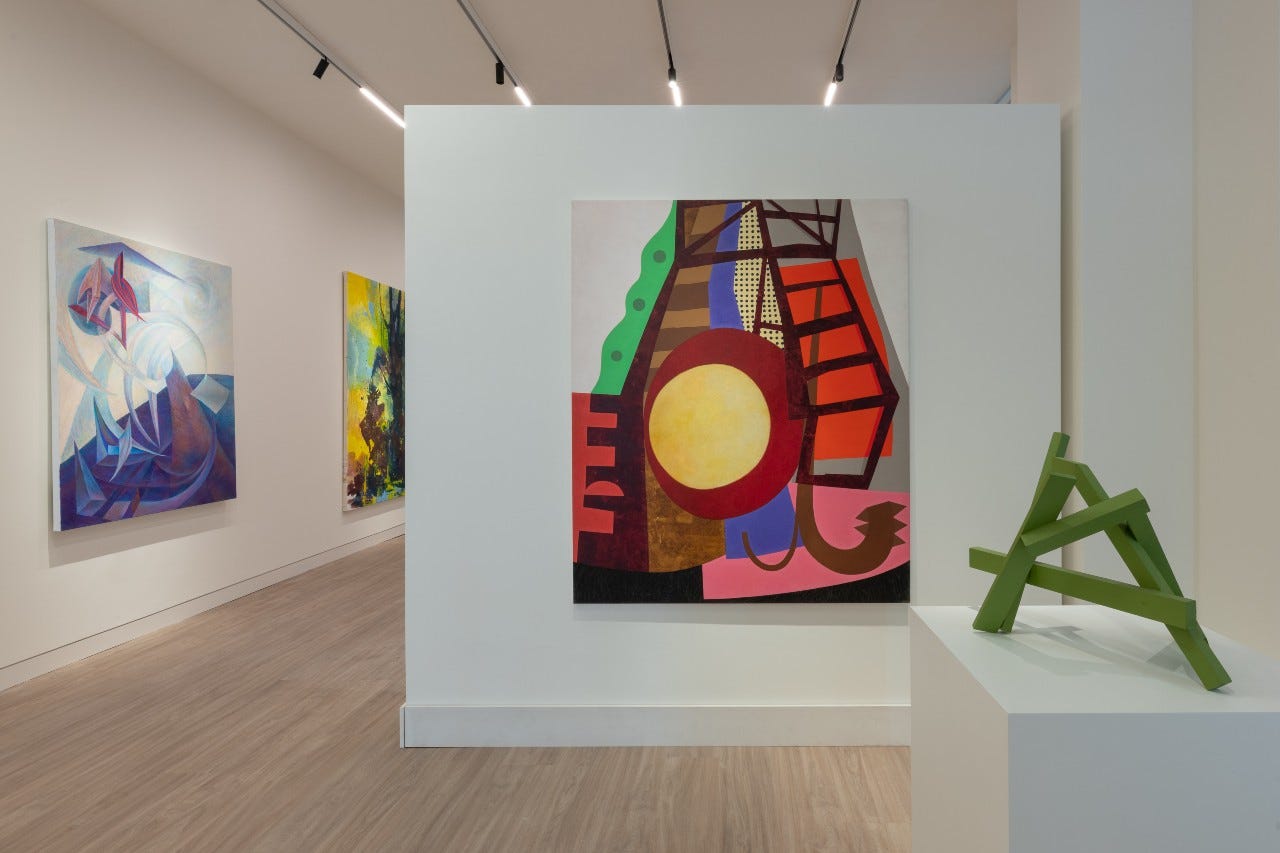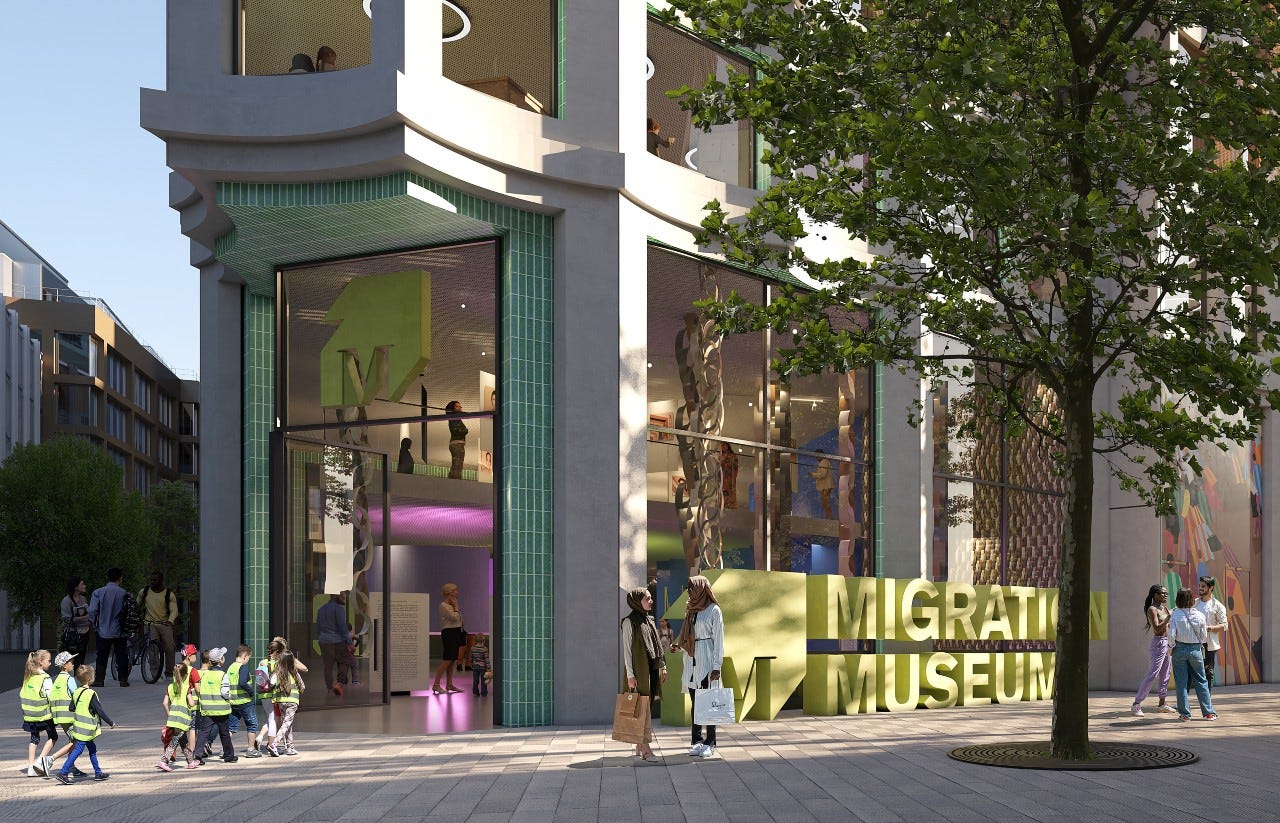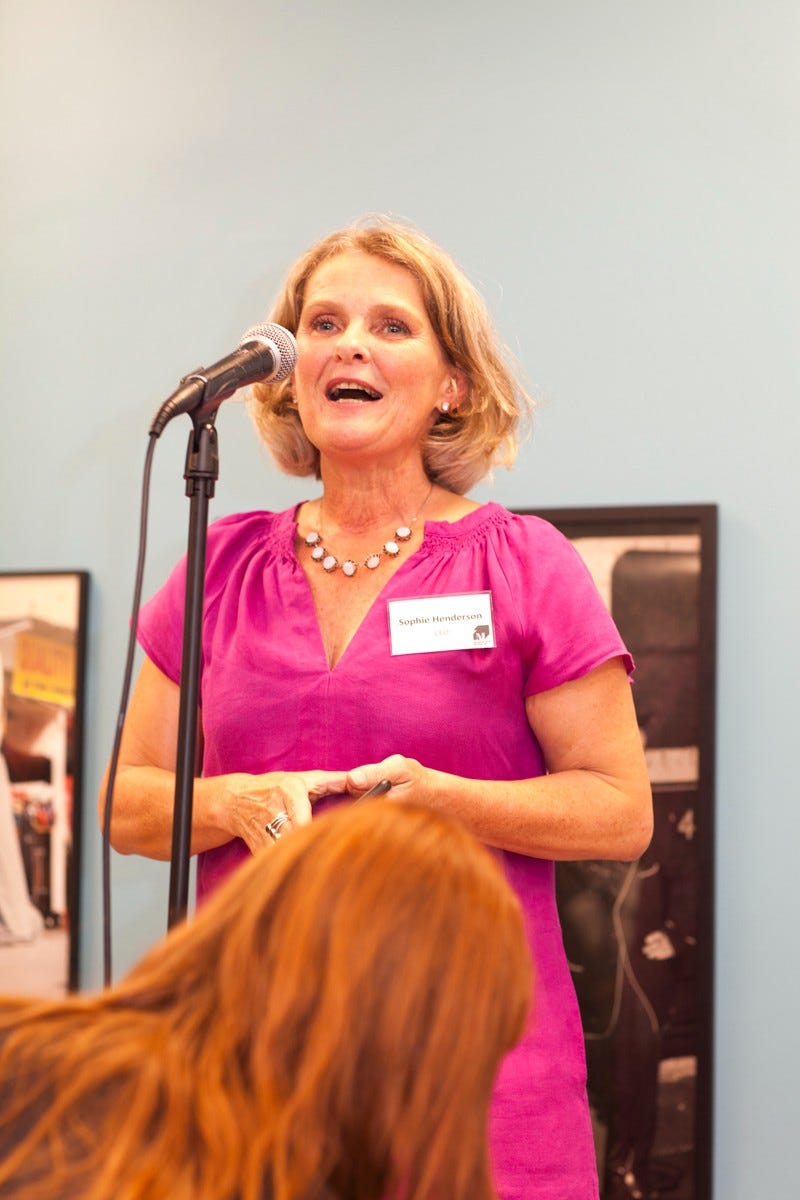— In partnership with Smartify
Hello.
It’s Tuesday, which means it’s ‘views and interviews’. You’re welcome.
London’s importance in the global art market is waning according to experts. Auction earnings have dived, annual sales axed, galleries are downsizing or closing. The money — and the buzz — is all heading to the Middle East and China. It’s gloomy.
Not so says the Founder of New York-based gallery Upsilon. In this week’s 250 Take Marcelo Zimmler writes why he’s putting his faith in the capital, by opening their first ever permanent international outpost in the heart of Mayfair.
The Migration Museum is also putting its faith in London. After a decade of pop-up exhibitions and temporary homes — including in a South London shopping centre — it has secured a permanent home right in the heart of the Square Mile. To mark the opening the museum’s final exhibition before it embarks on its big move, I speak to CEO Sophie Henderson in the Big Interview about the institution’s incredible journey, and its exciting future.
And my Hot List features Tracey Emin, and how Banksy saved art history.
Let’s dive right in!
— maxwell
*Purchasing through links in this edition may earn me a valuable affiliate commission
— In partnership with Smartify
Don't forget these valuable voices
If you visit lots of museums and galleries (and you do, because you're reading this!) then you'll know that the people who work there are a GOLDMINE of info on their collections. Their passion is palpable.
You'll also know just how rich, varied and valuable responses to art and culture from people outside the sector can be.
So it's no surprise to me to learn that Smartify and the Sainsbury Centre decided to put a range of voices from the museum and beyond at the heart of their new audio tours, Living Art and Sharing Stories.
It’s also the reason that young visitors are guided around museums by other kids, in the family experiences that Smartify creates.
In fact, Smartify have produced countless other tours and digital experiences based on co-creation like this. They're experts in using a range of voices and perspectives in their content. They're experts in creating together.
If your venue could do with fresh new collaborative and creative experiences for visitors, then find out what Smartify could achieve for you.
The 250 Take
Today’s 250-word opinion column from a guest writer is penned by the Founder and CEO of Upsilon Gallery Marcelo Zimmler. Here he explains why he’s putting his faith in London’s Mayfair by opening a new gallery here, despite predictions of the capital’s fading kudos.
💬 Ignore the gloom. London — and Mayfair — still reign supreme in the global art world
“There’s been much fear for the future of London as an art capital. But I’ve chosen this great city for my first international outpost because it perfectly combines cultural history, market resilience, and global influence.
After years of working with European collectors, establishing a physical space here allows me to better serve this market. Despite Brexit, the UK remains Europe’s leading art market, ranking third globally after the US and China.
Mayfair was a deliberate choice, offering a unique blend of tradition and contemporary relevance, similar to New York’s Upper East Side. It’s where emerging talent and established institutions coexist, creating fertile ground for innovation and growth. This is crucial as primary market artists become increasingly central to my gallery’s programme and business model.
The UK capital’s vibrant art scene, bolstered by prestigious institutions and a new wave of young artists, particularly female painters, provides a valuable opportunity to add fresh, distinct voices to the gallery’s programme.
Selecting Mayfair over other growing art neighbourhoods like Fitzrovia was a calculated risk — it requires higher commitment but offers unparalleled access to the world’s most influential collectors and institutions. This move isn’t just about opening a gallery; it’s about making a statement.
By choosing Mayfair, I’m aligning with a market that continues to lead and influence on a global scale, showcasing the vitality and relevance of the UK in the art world. This decision reflects my confidence in the British art market’s health and its pivotal role in shaping the future of the international art scene.”
Upsilon’s new London gallery is now open, and inaugural exhibition Upsilon Unveiled runs until 5 October.
The Hot List
My curated round-up of what’s new to see, do, watch, read and more. From the UK — and around the world.
FILM
1️⃣ Lee | a Sky Original Film
See Kate Winslet star as pioneering war, fine art and fashion photographer Lee Miller. This partial biopic focusses on Miller’s fight to document the horrors of WWII on the front line.
in UK and Irish cinemas now | read the Observer’s review
BOOK
2️⃣ Tracey Emin Paintings | by David Dawson, Jennifer Higgie and Tracey Emin
This is first serious study on the paintings of the celebrated British artist. It features over 300 images of Emin’s expressive figurative paintings from the 1990s to today, plus essays and interviews.
published by Phaidon | order your copy here here
TALK
3️⃣ The Trouble with Museums | from the National Gallery of Art, Washington DC
Dame Mary Beard presents an in-depth presentation exploring the disputes, debates, scandals, and controversies around museums throughout their history.
Thursday 26 September 16:00 EDT, free \ register to watch online here
EXHIBITION
4️⃣ Michael Craig-Martin | at the Royal Academy, London
This huge retrospective of Craig-Martin’s 60-year career is “inescapably joyful” according to the Evening Standard. See new work alongside his famous large-scale, vivid colour paintings of everyday objects.
now open until 10 December | find out more
BOOK
5️⃣ How Banksy Saved Art History | by Kelly Grovier
This entertaining exploration of art history through Banksy’s lens presents many of his most recognizable works, and examines how they show a profound understanding of the story of art.
published Thames & Hudson | buy your copy here
The Big Interview
The Migration Museum is migrating. After a decade of pop-up exhibitions and temporary homes, it’s secured its first permanent home in the heart of London’s financial district, which it’ll move into by 2027. The museum’s establishment and growth is a remarkable story — much like the remarkable stories the museum spotlights.
But what is the Migration Museum if you’ve not heard of it? Well since 2013, it’s explored how the movement of people to and from the UK across the ages has shaped who we are – as individuals, as communities, and as nations.
Migration is a pressing contemporary issue and is at the centre of polarised political and online debate. This means the museum — and its staff — face unique challenges that most other cultural institutions thankfully swerve. This summer’s violence on the streets of Britain only re-emphasised that.
Since 2020, the Migration Museum has been based in a temporary venue in a busy shopping centre in Lewisham, south-east London. But it’s time there is coming to an end as it prepares to move to its shiny new Square Mile home.
They’re going out with a bang, with one final exhibition which brings together highlights from the Migration Museum’s work over the past decade.
To mark the opening of this Lewisham swan song — and to get the lowdown on the plans for the new museum — today’s interview is with CEO Sophie Henderson. Here we chat how they used such an unusual museum space over recent years, how the polarised debate on migration effects the museum and its staff, and the tough fundraising campaign that lies ahead.
***
Hi Sophie. You’ve just opened a milestone new exhibition. Tell us about it.
Our new exhibition All Our Stories brings together the ‘greatest hits’ from our exhibitions over the last decade alongside newly-commissioned works to explore how migration has shaped Britain in different ways over many centuries.
It’s a major milestone for us as we recently celebrated our tenth anniversary, and we’re so proud of our journey. We started with pop-up exhibitions and events at different venues around the UK before moving into our current temporary home in Lewisham Shopping Centre in 2020. This is our last exhibition before we move to our brand-new permanent home in central London in 2027.
All Our Stories features a number of new installations too. Do you have any favourites?
It’s so hard to choose! One of the first things you’ll see as you enter is a room-sized new film installation by award-winning animator and filmmaker Osbert Parker, which immerses you in centuries of Britain’s migration history. Migration has a rich, long history in Britain, and Osbert’s film really brings this to life in such an immersive and creative way.
Another artwork that moves me is a large-scale sculptural work by Kurdish artist Shorsh Saleh that takes the form of giant chairs sinking into the floor, inspired by the seemingly endless process of waiting during the eight years it took for his asylum application to be granted. Shorsh was artist in residence at our previous temporary venue in Lambeth and this piece is a large-scale version of a work that he initially made during his residency. It’s incredibly powerful — and also speaks to the meaningful relationships we’ve built with so many contributors and artists over the past decade and more.

Does it feel more timely opening this show just weeks after the widespread riots we saw across Britain? And with migration often a polarising subject in the UK, what do you see as the museum's role in this national discourse?
Migration is always front of mind for us given our mission, but the racist violence we saw over the summer unfortunately has made this exhibition feel more timely and our work feel more urgent.
I think it’s important to remember that the riots did not happen in a vacuum; they were a product of long term political and media discourse that has been extremely damaging and dangerous for migrants and ethnic minority communities in the UK. You only have to look at the installation by Liz Gerard in All Our Stories, which is a collection of newspaper front pages about migration from 2016. So many of the headlines are sensationalist and inflammatory. And the recent violence shows how quickly this divisive rhetoric can escalate into something much more serious.
Our work has always emphasised the fact that migration is a long, shared story in Britain; it touches all our lives in some way, whether we know it or not. By grounding our exhibitions in human, personal experiences, we hope that we can be a place where people see themselves reflected, but also a place of discovery and creating connection and unity over division and hate.
And by putting our shared migration story symbolically and substantively at the heart of our cultural landscape and our national story, we hope to contribute to a better and more inclusive conversation about migration. But we can’t do this alone, which is why we’re aiming to work with partners across the museums and heritage sector and beyond to platform and amplify migration stories across the UK.
On a day-to-day basis, how does the discourse around migration affect you and your team's work?
Given the often toxic nature of the discourse around migration, our team do sometimes encounter hostility — and occasionally overt racism — from some visitors, usually from people who haven’t engaged in a meaningful way with our content or exhibitions.
And we also get abusive messages and trolling on social media, in particular on X, which has become a much nastier place. The wellbeing and safety of our team is always our priority, and we have specialist training, protocols and policies in place to support team members — in particular our front-of-house and social media teams, who are most likely to encounter hostility directly. I’d also say that as a team we are incredibly supportive and protective of each other.
But without wanting to downplay the severity or the burden of being subjected to abuse in any way, I would stress that the vast majority of our interactions with the public, both online and in person, are extremely positive. Many visitors often have a deep emotional response to our work, which shows that, far from being a controversial or divisive topic, migration has the power and potential to unite us through shared stories and connections. And most people welcome and appreciate the space we provide for people to come together to do just that.
This will be your final exhibition in Lewisham Shopping Centre. What are your reflections on five years in such an unusual 'museum' space?
It will be really emotional to leave Lewisham. We’ve learnt so much and made so many memories here. On the one hand, there have been challenges in that it is not a conventional museum space in central London, meaning people have to travel further to find us. And the complete lack of natural light in our back of house areas does take its toll on all of our wellbeing — it turns out that retail stock rooms don’t make ideal offices! But, in so many other ways, being based here has been brilliant.
We’ve been welcomed with open arms and have made amazing connections with the community here, we’ve made creative use of our former retail space — for example by converting changing rooms into listening booths. And by being based in a shopping centre, we’ve reached people we might not have otherwise, many of whom don’t visit other museums or galleries. People pop in while doing their shop, then return with their friends, kids, grandparents and become regular visitors. Our audiences are much more ethnically and socio-economically diverse than the London museums and galleries average and much more representative of the actual local population. Our location in Lewisham Shopping Centre has contributed to this.
Visitors often say to us that they wish we could stay here. A part of me does too. But this was always only a temporary venue for us, and we now have a once-in-a-generation opportunity to create a permanent museum in central London where we can reach and engage many more people. It does feel like the right time to move on, and we hope to bring as many of our current visitors in Lewisham as possible with us on our journey.
How did you secure your new location in the City of London, and what was Sukhpal Singh Ahluwalia's involvement?
Sukhpal has been a Distinguished Friend of the Migration Museum for many years, and we first featured his story in an exhibition — he arrived in Britain as a refugee fleeing Idi Amin’s Uganda in 1972 and made his fortune by building a car parts business from the ground up before moving into property development. So, like so much of what we do, the relationship started with a personal story.
Sukhpal’s company Dominus invited us to become the cultural tenant in a new development in the City of London. Our museum will be located on the first three floors of the building, a space around three times larger than our current venue in Lewisham, with the remainder allocated to student accommodation. The City of London authorities also have been very enthusiastic about us being based in the Square Mile.
The relationship with Dominus goes far deeper than business. Sukhpal and his family are personally invested in the Migration Museum and our mission, and have backed us not only by providing us with a venue — that’s rent and service charge free for 60 years — but also by becoming one of our founding donors. We are immensely grateful and look forward to continuing to work closely in partnership with Dominus to help to make our vision for a permanent Migration Museum for Britain a reality.
How much money do you need to raise to complete the new permanent home? And how are you going to raise it?
We are seeking to raise £20m in total to fit out the building, create our digital infrastructure and ensure a dynamic and sustainable institution that will put the UK’s migration story on the map.
We now have a fantastic development team in place and are embarking on the initial ‘private’ phase of our capital campaign, aimed at bringing foundational individual, institutional and corporate donors on board ahead of a mass-participatory, movement-building ‘public’ second phase closer to launch.
Along with Sukhpal, our chair of trustees Charles Gurassa has generously committed to being a founding donor. We have received an initial grant from the National Lottery Heritage Fund to enable us to explore partnerships and scope migration-related objects, records and stories in existing museum and heritage-sector collections, which we hope will be the prelude to a larger application to NLHF further down the line.
We have also received funding from Arts Council England to create a new website and digital infrastructure. And we are currently in conversations with a number of prospects, as cultivation is our number-one priority over the coming months. To that end, we hope that All Our Stories will act as a showcase and a galvanising force to support our cultivation activities.
Will you begin establishing your own collection for the new museum?
While we don’t have a formal collection of objects in the traditional sense, we have collected thousands of personal migration stories from visitors over the years in the form of handwritten story discs, as well as hundreds of oral histories and recordings that have featured in our exhibitions. Together, these represent an important collection of stories that historically haven’t always been prioritised or valued and may otherwise be lost. Many of these stories and oral histories feature in All Our Stories.
We’ve also commissioned dozens of artistic responses to the themes we explore — again, many of which feature in our new exhibition. Individuals have also entrusted us with treasured personal possessions that speak to their own migration journeys and experiences. We are in the process of digitising our existing collections — and I’m getting more comfortable using that word.
Looking forward to our new museum, we do aspire to establish our own small collection of objects. But we know that there are already so many incredible objects and stories within existing collections across the UK which speak powerfully to the central role that migration has always played in our lives, so our vision is for a dispersed ‘collection’ that can platform and highlight migration stories embedded within existing collections.
Finally, what do you think will give you the most sleepless nights over the move?
Gosh, this is a terrifying question — if I think too hard about everything that needs to be done ahead of the move, I’ll be lucky if I get any sleep at all over the next few years!
Unless we can raise the funds, we won’t be able to realise this incredible opportunity and to achieve the goal that the team and I have been working so hard towards for so many years. So fundraising has to be our number-one priority — and so will be the number-one cause of sleepless nights.
I also feel a deep duty and responsibility to our incredible team. We all care so much about this project. It’s what’s got us this far, and this passion and commitment is what will enable us to get over the line and create a genuinely groundbreaking new permanent museum that couldn’t be more timely or relevant. But we have a lot of work to do.
All Our Stories: Migration and the Making of Britain runs at the Migration Museum until December 2025. Entry is free. The museum’s move to a permanent home in the City of London is earmarked to open in 2027.
Enjoyed this newsletter? It took many hours to put together. Donate now to support me as I continue to bring you insights from the world of museums, galleries, art and heritage.







